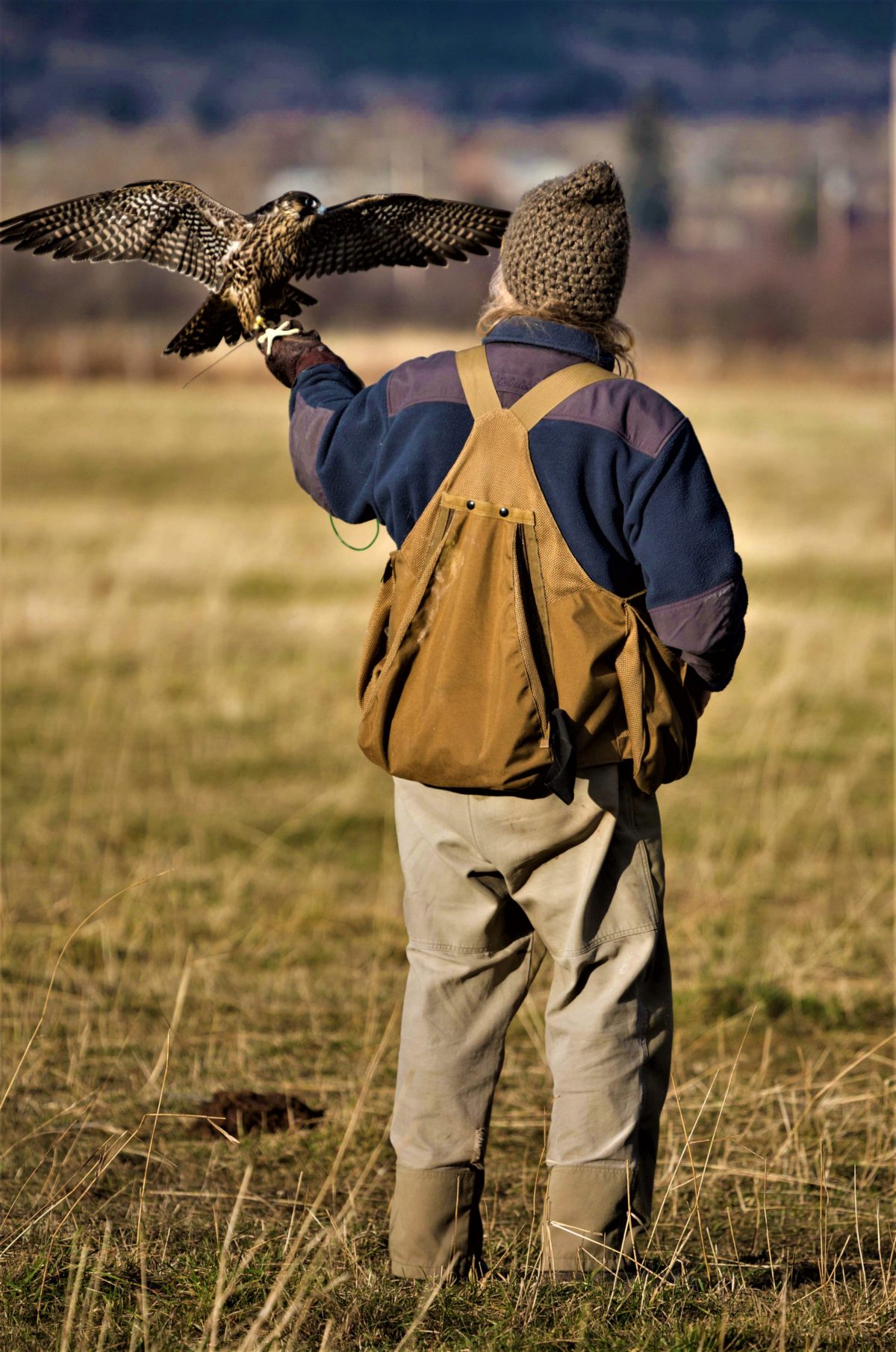One of the reasons my blog productivity has waned a bit this summer is because of my hobby (or alternative lifestyle!) of falconry. I have been busy raising and training a new falcon. Terry has bugged me for some time to make Lola a subject of this blog, so here you go.
Allow me to introduce you to Lola, my female prairie falcon.
 With the help of a friend, I took Lola from her eyrie – a small cave in the side of a cliff – on May 31st when she was approximately 17 days old. She was huddled together with 1 sister, 2 brothers, and 1 egg that failed to hatch. This is the average size for a prairie falcon eyrie.
With the help of a friend, I took Lola from her eyrie – a small cave in the side of a cliff – on May 31st when she was approximately 17 days old. She was huddled together with 1 sister, 2 brothers, and 1 egg that failed to hatch. This is the average size for a prairie falcon eyrie.
For anyone worried about this practice, let me say that I probably saved Lola’s life. Biologists estimate that the mortality rate among 1st year raptors is about 75%. In other words, there is a 75% chance Lola would have died before next spring had I not taken her. Nature is beautiful, but it is also harsh, can be cruel (at least, in our eyes) and is always unforgiving.
Prairie falcons are very common in the western United States. Unlike the peregrine falcon, which was saved from extinction by conservation

efforts facilitated through the Environmental Protection Agency’s enforcement of the Endangered Species Act, prairie falcon populations have never been so low as to be threatened, much less endangered.
(I am biting my tongue not to excoriate president Trump’s gutting of the EPA and the current plan to effectively terminate the ESA! All God’s people ought to be screaming bloody murder over these catastrophes. Maybe I will do that in a future post.)
Here are a few things to know about Lola:
- She is an “imprint,” meaning that she thinks I am her dad (or mom?). Both

Lola at 17 days having her first meal at her new home. prairie and peregrine falcons will imprint up to the age of 21 days. There are both pros and cons to training an imprinted falcon. I have never done it before, and I am experimenting. So, I decided to give it a try for a variety of reasons. Maybe I will talk more about imprinting on another day.
- One of the benefits of imprinting is that Lola is as tame as a puppy dog. She likes to hang out with me in the living room, which makes her lots of fun…for now. We will see how things work out in the coming months once she begins serious training and hunting.
- No, imprinting does not necessarily mean that she can never be released or

Teaching Lola how to interpret the news. be able to mate and raise young in the wild. We don’t thoroughly understand the imprinting process, yet. There are documented instances of imprinted raptors mating with their wild counterpart and nesting in the wild successfully.
- I wanted a female because the primary game species in my area throughout the winter is pheasants. Female raptors are about 1/3 larger than males. I want to be able to hunt rooster pheasants when they flush, and a male prairie falcon would be too small to kill male pheasants consistently.
- When Lola was small I took her with me

My two favorite little girls playing on the porch. everywhere, except when my shopping required leaving her in the car alone for long periods. She enjoyed sitting on the table with me in her wicker basket at my local coffee shop, meeting the customers coming and going. It’s called socialization. When raising an imprint, I had to ensure that Lola had food available 24/7, never experience unsatisfied hunger, did experience a broad spectrum of activity, and was always with me.

They grow up so fast. - Soon after Lola could fly, we began a procedure called “hack.” There are a variety of ways to approach hacking, but it basically means that the hawk or falcon is allowed to fly around on its own during the day. So, every day Lola and I drive out to a beautiful, isolated valley – no people, roads, buildings, power lines or telephone poles – that virtually screams “Montana!” Out here I can be reasonably certain that she will remain safe as she explores.I set her on the roof of my Jeep and let her do her thing. Right now her

Lola’s favorite inside perch on the banister. “thing” includes chasing larks, harassing the neighborhood marsh hawk, learning to use the wind, gaining self-confidence, muscle tone, stamina, strength and just lookin’ incredibly cool in the way that only big falcons can do. Don’t worry. Lola regularly returns to land on the Jeep roof as if to say, “Ain’t I the ritz, dad? Did you see that?!”
Just to make sure I stay focused, she often buzzes my head for fun. After 2 hours or so, at some point when she is standing on the roof, I offer her the lure (a leather thingy that I can

Lola at hack, queen of her domain. swing in the air) with her daily meal attached. She flies or jumps over, grabs the lure, begins to eat, and I get her ready to go back home.
- Well, that’s what Lola and I are up to now. I will let you know how we progress in the months ahead.
